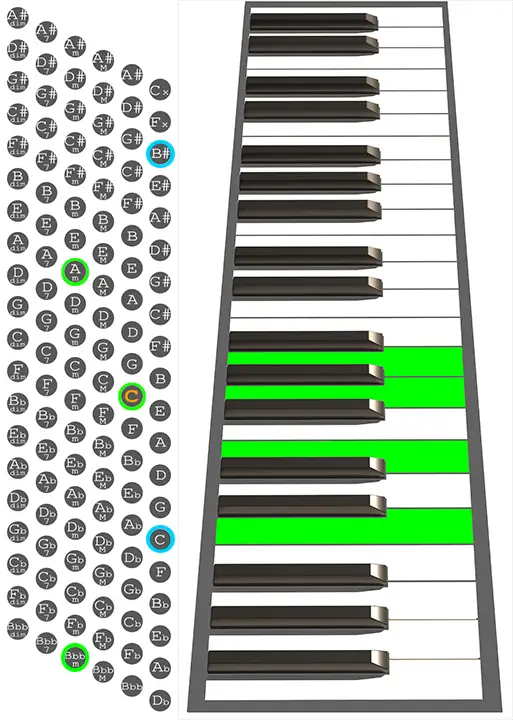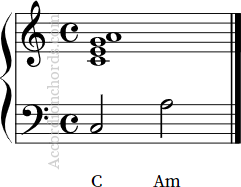AKA: C6, C6th, Cadd6, CM6, CMaj6, C Major sixth, C major6, C sixth
C6 Accordion Chord Chart

Major 6th Chords
A major 6th chord is a four-note chord that contains the Root, the 3rd, the 5th, and the 6th of the major scale. In terms of intervals, a major sixth chord contains a major 3rd, perfect 5th, and major 6th. In other words, it’s a major triad with an added 6th.
The formula for major chords is R, 3°, 5°, 6°. In C6 we have the notes C, E, G, A.
Major 6th chords are very common in pop, rock, and jazz music.
Equivalent chord:
The third inversion of a 6th chord is equivalent to a min7 chord. The sixth of the 6th chord is the root of the min7th chord.
In this case:
The third inversion of C6 (C, E, G, A) is equivalent to Am7 (A, C, E, G).
(Please note that chord inversions do not work on the Stradella bass system like they do on other instruments or on the accordion keyboard itself. So although these equivalent chords have the exact same notes, they are not interchangeable and should not be intended as inversions of the same chord, at least for what concerns the left hand.)
6th Chords on Accordion
On a standard bass accordion, you can play major 6th chords (with no 5th) by combining the Root with the minor chord of its 6th interval. If C is the Root, adding an A minor you get a C6(5th omitted). You should add the major chord of the Root to get a full 6th chord but the 5th doesn’t add any tension so it can be omitted.

Notes:
C, E, G, A
Intervals:
R, 3°, 5°, 6°
Left hand:
C + Am
Fingering:
4 + 2 or 5 + 2
Why not use CM Chord and Counter-Bass A of F row?
If your playing a Harmonic Chord (Simultaneous) rather than Broken chord on the LEFT hand.
Obviously in the CM Bass with counter-bass “A”, The “A” would be an octave lower but it would still be a C6. Just inverted.
No, you can’t use a separate bass note like “A” to complete a C6 chord on the left hand, even as a harmonic chord. The reason is rooted in how we perceive low-frequency sounds.
When two bass notes are played simultaneously—especially in the low register of the accordion—they create interference and masking effects. This makes it impossible for our ears to clearly identify the root note, which is essential for perceiving the chord correctly. In other words, the additional low “A” would obscure the C root rather than reinforce it, so the resulting harmony is unclear and ineffective.